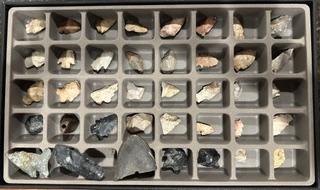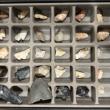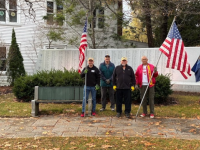Lady Knox Chapter, DAR holds recognizes Indigenous mounds and earthworks at October meeting
Lady Knox Chapter Daughters of the American Revolution’s October 25 meeting included a talk and service project in support of Indigenous history, culture, and education.
The meeting opened with a land acknowledgement recognizing the original Indigenous people who lived on the lands in and around Knox County prior to European colonization. Each month, the Chapter opens the meeting with an acknowledgment and shares an Indigenous Persons Minute in the form of a short video or reading about the history, culture, or current events and activities of Indigenous Maine peoples. Each meeting includes a program.
In recognition of Indigenous People’s Day, October 13, the October program was a talk by Mary Kay Felton on Indigenous Mounds and Earthworks of the Adena, Hopewell, and Fort Ancient Cultures. Felton’s ancestors lived in Maine for many generations, but she grew up in Ohio. In 1790, when the Treaty of Greenville was signed by General Anthony Wayne, Ohio was the original Indian Territory for local, relocated, and migrating tribes.
Felton’s talk briefly touched on ancient mounds from China, Japan, England, Ireland and Wales, but the primary focus was on the extensive mound formations of Ohio. Unlike Maine’s Indigenous mounds, which are mostly shell middens, Ohio’s mounds are burial mounds, ceremonial mounds, and effigy mounds built primarily between 1000 BCE and 1000 CE during the Woodlands Period, though some mounds were constructed as recently as 1650 CE. Effigy mounds were often built in the shape of birds or animals, like bear, bison, deer, and lynx, to name a few. Effigy mounds were not burial mounds. They were often constructed as calendar mounds that marked the seasons and the solstice.
Mound evidence suggests the local indigenous people understood the 18.6 year lunar cycle. The Mound builders were knowledgeable astronomers, artists, civil engineers, and mathematicians with an extensive trade network extending from the Rocky Mountains to the Midwest and from the Great Lakes to the Gulf of Mexico. Some of Ohio’s most important mounds and earthworks are protected properties designated as UNESCO World Heritage Sites, including Fort Ancient Earthworks, Hopewell Culture National Historical Park, Mound City Group, Hopewell Mound Group, Seip Earthworks, High Bank Earthworks, Hopeton Earthworks, and the extensive Newark Earthworks. Great Serpent Mound, one of only three known serpent effigy mounds in the world has also been nominated for UNESCO World Heritage designation.
Following Felton’s talk, the Lady Knox Chapter, DAR voted to support a group of Maine’s Indigenous children by making a donation of school supplies to the Indian Island School.
“Anytime we can invest in the children of Maine,” said Felton, “we invest in the future of Maine.”
For more information about this program, or upcoming programs of Daughters of the American Revolution, contact Mary Kay Felton at feltonmk@gmail.com.



























